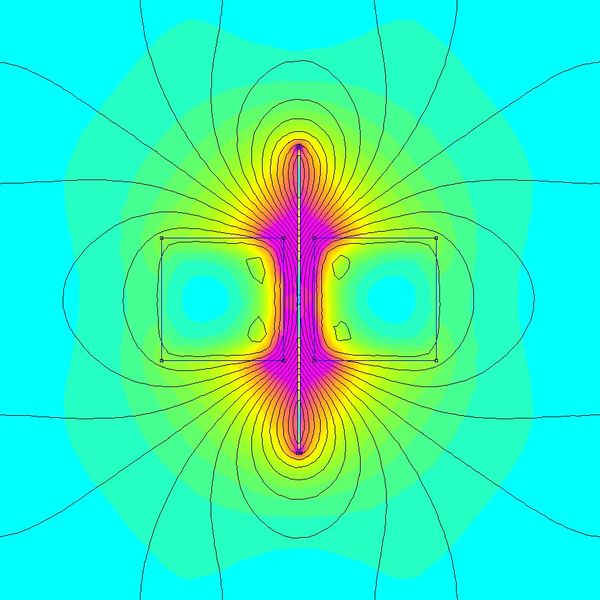if all size parameters where held constant then the resistance property of material would be the last remaining variable, no?
and the lower the resistance the better the effect on reducing inductance?
i wonder if gold would show an even greater effect?
marketing people would have a field day with that! but cost would skyrocket!
and the lower the resistance the better the effect on reducing inductance?
i wonder if gold would show an even greater effect?
marketing people would have a field day with that! but cost would skyrocket!
I don’t see that trend. If I use a copper sleeve of half the diameter. The inductance would be reduced only to some 124 uH. Probably there are other benefits using other material. I tend to think maybe some benefits in the lower frequency. I will see if I can get material with exactly same diameter.
If you put a sheet of cooper in the gap, it reduces the magnetic flux, so in order to have the same magnetic flux you must increase the coil size... and its inductance ?
To the extent transformer action is involved it would be a losing game. The shorted secondary would dominate.
Normally one would increase magnet size.
Yes, but the electromagnetic permeability of the pole parts (and the air) is limited and once these parts are saturated, the only way to maintain the motor magnetic field intensity is to enlarge the gap height, therefore it should enlarge the coil ?
Last edited:
question: doesn't the shape matter? i can see how a tube would work in redistributing eddy currents along it's length but the flat plate would only serve to redirect the flux out of the gap.
I don’t think I fully understand the interaction, but generally if the voice coil is circular, then the shorting ring would follow. It kind of shields the iron influence on the coil, but since inductance drops regardless whether there is an iron core or not...
Another thing interesting that there seems to be some capacitance between the coil and the iron plates, shorting the coil to the iron tends to make the sound more focused and clean. This has been mentioned in other threads.
on a quick investigation of material properties it appears paramagnetic materials are those which can pass a magnetic field but don't retain the field (permanence)
and a quick look at charts suggests tungsten would be better than aluminum.
tungsten is higher resistance than aluminum but apparently has better paramagnetic properties.
so i'm wondering if there is a possibility/material that would allow the redistribution/equalization of the eddy currents without reducing overall flux via the "transformer effect"?
and a quick look at charts suggests tungsten would be better than aluminum.
tungsten is higher resistance than aluminum but apparently has better paramagnetic properties.
so i'm wondering if there is a possibility/material that would allow the redistribution/equalization of the eddy currents without reducing overall flux via the "transformer effect"?
If you put a sheet of cooper in the gap, it reduces the magnetic flux, so in order to have the same magnetic flux you must increase the coil size... and its inductance ?
Why would copper, a non-magnetic metal, have any effect on the magnetic field? And what exactly is that a picture of? It doesn't look like a flux pattern from a permanent magnet. It looks like the flux from a current sheet.
So, if we have conducting cylinder as a secondary, and it's resistivity is low, mostly what happens is we have it's leakage inductance in parallel with the primary magnetizing inductance, and both of those in series with the primary leakage inductance. So inductance seen from the primary terminals drops. This is about the same as having shorted secondary in any transformer, the inductance as seen from the primary terminals goes down. Is there a problem I am missing?
I agree that the inductance goes down, that was never my concern. My issue was the inductance going down further with increased resistance of the shorted turn - as shown in the photos. I do not see how this would happen even in your model. But I am also realizing that something else must be wrong as an iron core in a voice col should raise the inductance, but the photos claim that it falls.
I agree that the inductance goes down, that was never my concern. My issue was the inductance going down further with increased resistance of the shorted turn - as shown in the photos. I do not see how this would happen even in your model.
I don't see how that would happen either, but I'm not sure which photos you are referring to. I was just using a mental model of coil and conductive cylinder inside.
An iron core would be conductive, have eddy currents, etc., unless it were laminated to prevent that.
Last edited:
Why would copper, a non-magnetic metal, have any effect on the magnetic field? And what exactly is that a picture of? It doesn't look like a flux pattern from a permanent magnet. It looks like the flux from a current sheet.
Copper is a diamagnetic material.
electromagnetism - Why is copper diamagnetic? - Physics Stack Exchange
But if we ignore the magnetic properties of the copper, it enlarges the pole parts gap, therefore lowers the magnetic field intensity (and its linearity)
Copper is only slightly diamagnetic, and the coil is probably made out of it. Wouldn't expect much of an effect.
An interesting thing that I haven't seen discussed here might be "armature reaction," which results in magnetic field distortion in motors. You guys know about that?
An interesting thing that I haven't seen discussed here might be "armature reaction," which results in magnetic field distortion in motors. You guys know about that?
- Home
- Loudspeakers
- Multi-Way
- Who makes the lowest distortion speaker drivers
